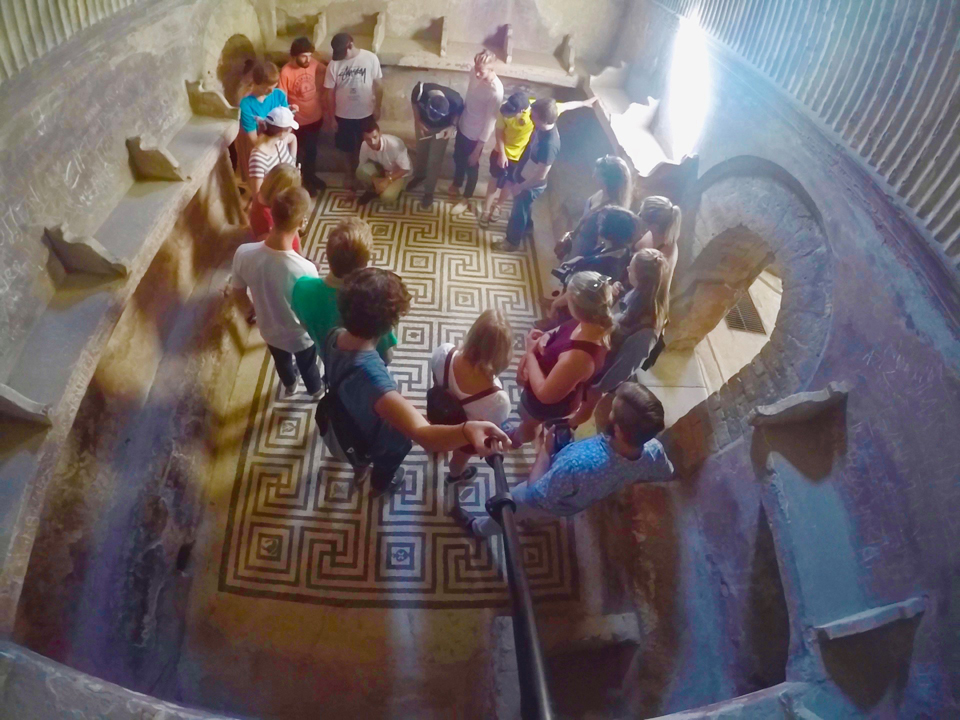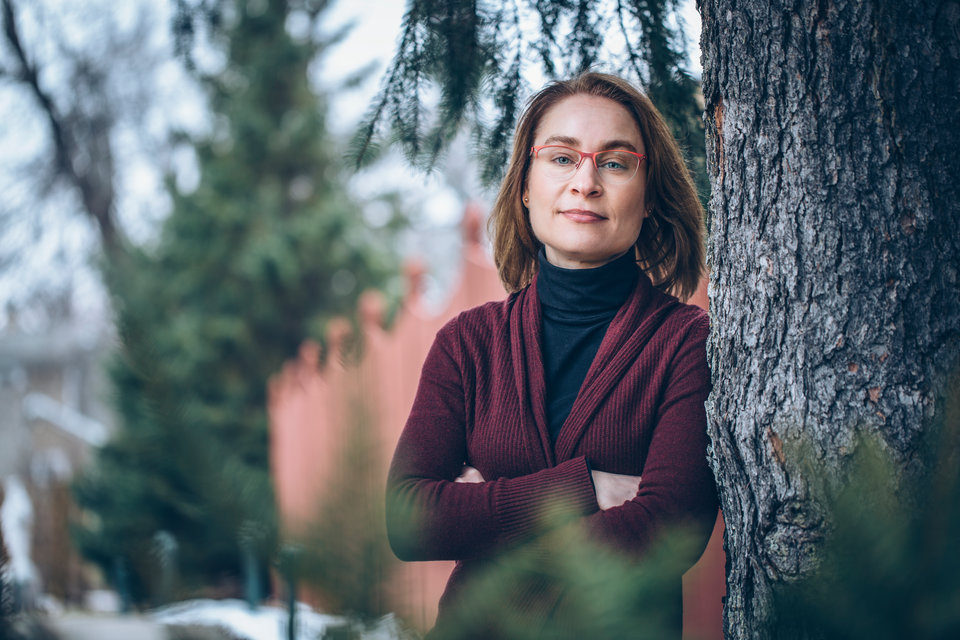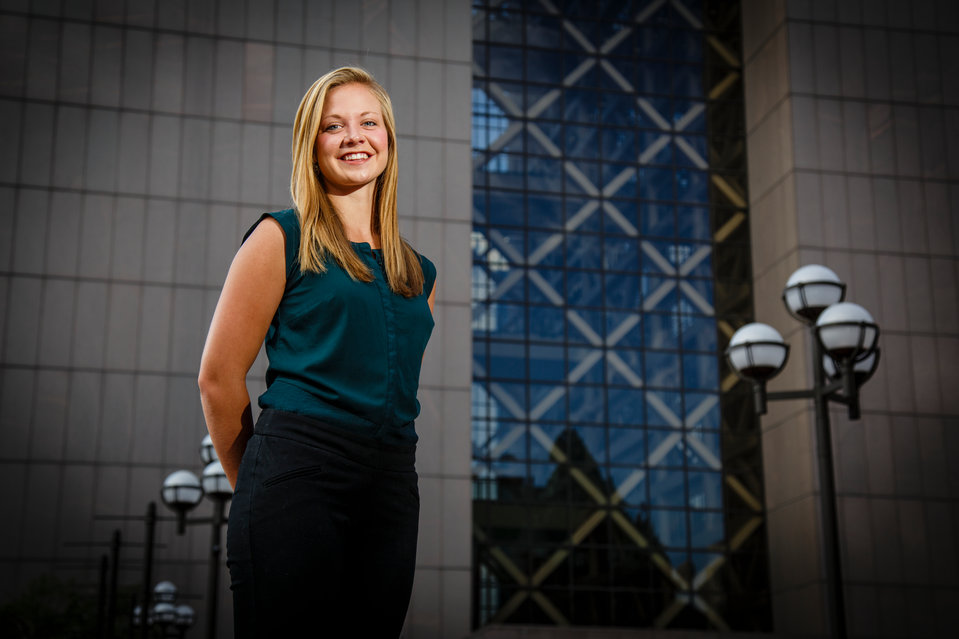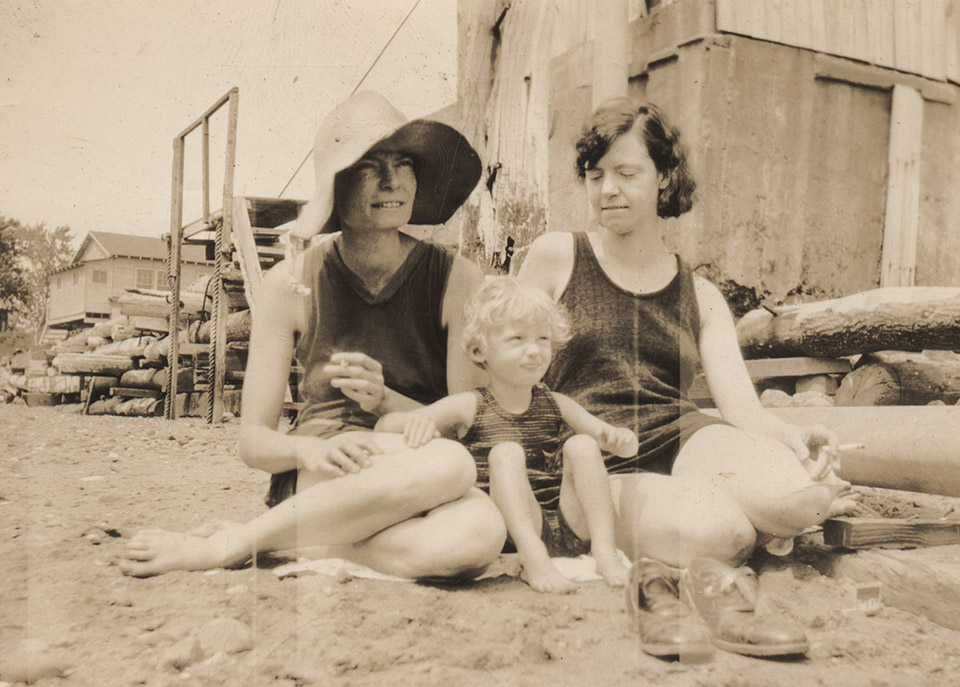Melissa Joyce is too outgoing and friendly to seem like the calculating type, yet she obviously knows how to do chemical calculations. For the past two summers, she has been one of many University of St. Thomas undergraduates conducting research in the Chemistry Department as part of its Summer Undergraduate Research Program. Joyce, a chemistry major and math minor, has been working with Joseph Brom '64, professor and department chair, whose specialties are physical and computational chemistry.
"During my summer research, I learned how to never give up even if some days it was tempting to throw my computer out the window!" Joyce said. "I learned that it is OK to be confused and fumble around for a while because this is truly the way to learn something. Sometimes in the process of fumbling you discover something you might not have if you had been following a cookie-cutter lab experiment."
Brom said it a different way: "Students have to learn to accept that new knowledge in chemistry is obtained only after much failure along the way. When success is finally achieved, it is a glorious experience. During the summer, our students have time to learn this."
Last August, Joyce's poster, "A Computational Study of TiH5+ and CH5+," won the first-place award in the chemistry division at the MRSEC (Materials Research Science and Engineering Center) Summer Undergraduate Research Expo held at the University of Minnesota and sponsored by its Institute of Technology.
At the event, St. Thomas chemistry students accounted for nearly half of the 58 posters presented in the chemistry division by students from across the United States, and they won two of the top three chemistry awards. In addition to Joyce's first-place finish, a third-place award was won by Gregory Crane, student of Katherine Olson of the St. Thomas Chemistry Department, for his poster, "Real-Time qPCR Analysis of mRNA Concentrations in Alzheimer's Infected Mice Brain Cells."
A rapidly growing programThese awards are a sample of the successes being enjoyed by students participating in the Chemistry Department's large, active and rapidly expanding summer research program. From small beginnings with a handful of summer students and faculty in the former Albertus Magnus Hall, the program now numbers approximately 50 students each summer under the guidance of (as of last summer) eight research-active faculty in Owens Science Hall, part of the Frey Science and Engineering Center, which opened in 1997.
Although most of the summer students are sophomore or junior chemistry or biochemistry majors (the spring 2009 graduating class included 12 chemistry majors and 30 biochemistry majors), students from other scientific disciplines often participate. Just as the number of students in the program has increased, the number of faculty research mentors will increase with the arrival of three new research-active faculty by the beginning of the 2010-2011 academic year. Although official statistics from comparable institutions are unavailable, the undergraduate summer research program sponsored by the St. Thomas Chemistry Department may well rank among the largest in the United States.
Matching students with faculty mentorsThe summer research season actually begins in February. Students enrolled in chemistry courses are invited to interview prospective research advisers to find the best possible match. A faculty committee extends offers to students based on the availability of funding and research space. Although a strong academic performance in relevant chemistry courses is a plus for an applicant, faculty mentors also value other qualities, including enthusiasm for laboratory work and the willingness to learn.
The areas of chemistry investigated are varied, and are drawn from all of the chemistry subdisciplines: analytical chemistry, biochemistry, inorganic chemistry, organic chemistry and physical chemistry. A sampling of titles from the recent MRSEC poster session shows the breadth (and depth) of interests: "Analysis of Algal Toxins in Minnesota Waters Using LC-MSMS," "The Synthesis of a Thiadiazole Functionalized Oxazolidinone," and "Nitrogen Homeostasis in the Invasive Argentine Ant."
Funding for these undergraduate researchers comes from an impressive array of sources, both public and private. Chemistry faculty in recent years have secured research grants from agencies including: the National Science Foundation, Research Corp., the American Association for the Advancement of Science, Merck Pharmaceuticals, and the Petroleum Research Fund of the American Chemical Society, and from companies including Vision-Ease, H.B. Fuller Co., Medtronic, Samsung, Aspen Research, Boston Scientific, Imation, Microtrace LLC, ARKRAY, Chromatic Technologies Inc., Martrex Inc., Hutchinson Technology, Hemostasis LLC, Pepsi, Research and Diagnostic Systems, and ExxonMobil. Support also has been provided internally through the Young Scholars program sponsored by the Undergraduate Research and Collaborative Inquiry program of the university.
Junior colleagues work closely with their faculty mentorsA day's work for a summer research student usually begins formally at nine in the morning and ends at five in the afternoon, but students soon learn that research cannot be measured by punching a clock.
Research also involves hours spent outside the laboratory, writing proposals and papers and reading journal articles. Although this might seem burdensome to the novice research student at first, it actually brings home a very important point: the students performing research in St. Thomas chemistry labs are not simply "pairs of hands" carrying out the work of their faculty mentors, they are, in fact, the junior colleagues of their faculty mentors, with the responsibilities and the privileges that this relationship entails. Faculty and students are partners in the production of new knowledge, an activity more all-encompassing and more demanding than the usual summer job. It is also incredibly satisfying and, not unimportantly, really fun.
A sense of camaraderie and common purpose is fostered throughout the summer by a weekly departmental research meeting. Students and faculty gather to share a pizza lunch, and several students give mini-seminars or "chalk talks" that describe the chemical problems they are exploring.
Another ongoing summer tradition is a series of three joint research meetings held with the summer undergraduate research groups of neighboring Macalester College and Hamline University. Student presentations are more formal than those at the weekly departmental pizza meeting and would be appreciated by a graduate-level audience or a group of chemical professionals.
The season finale occurs during the first week of August – the annual Chemistry Department Summer Undergraduate Research Poster Session. St. Thomas chemistry research students present posters describing their summer research to an audience of family, friends and St. Thomas faculty and administrators. Many of these students also present their work at the annual MRSEC Summer Research Expo held at the University of Minnesota that same week.
The research doesn’t end with summerMany students continue their work through the academic year. For several, the summer project becomes a multiyear endeavor. This was the case for Melissa Maurer-Jones '06 who put her keen interest in environmental issues to work in the analytical chemistry laboratory of Tony Borgerding through most of her academic career at UST. For the 2005-2006 academic year, Maurer-Jones was one of only 320 students nationwide to be awarded the prestigious Barry M. Goldwater Scholarship, authorized by the U.S. Congress in 1986 to honor Sen. Goldwater by encouraging excellence in science and mathematics. She is pursuing a Ph.D. in chemistry at the University of Minnesota.
Another Goldwater Scholar (for 2007-2008), Nathaniel Brandt '08, followed a multiyear path. Brandt worked throughout his undergraduate career in the Joseph Brom laboratory on projects in laser spectroscopy and photochemistry. He is a graduate chemistry student at the Massachusetts Institute of Technology.
However long each project lasts, and regardless of the chemical specialty, the goal is the same: the education of a future research scientist by conducting cutting-edge, publication-quality research with the collaboration of a faculty mentor.
Engaging the discipline nationwidePresentation opportunities provide a learning experience for the research student and an opportunity to "show the flag" of the Chemistry Department and the University of St. Thomas. They also represent a critically important aspect of research, the dissemination of scientific results.
Each year, the Chemistry Department sends a group of students to present their summer work to a national meeting of the American Chemical Society, the professional organization for chemists, which, at almost 155,000 members, is the world's largest scientific society. Students attending the spring meeting, which will be held in San Francisco in March, will have the opportunity to present their previous summer's work in a large poster session devoted to chemical undergraduate education. St. Thomas students also are planning to present their work in the "regular" sessions held for professional chemists, faculty, postdoctoral researchers and graduate students.
Closer to home, presentation opportunities are offered by the summer MRSEC meeting at the University of Minnesota and the Winchell Undergraduate Research Symposium sponsored by the Minnesota Academy of Science. Chemistry Department research students have fared very well at the Winchell Symposium in recent years. Joshua Speros '08, a graduate chemistry student at the University of Minnesota, and James Stokman '09, who has been accepted for admission to the medical school of the University of Minnesota-Duluth, won first-place awards in the chemistry division. Speros presented "Synthesis and Characterization of a Novel Polymerizable Chemiluminescent Compound" in 2008. Stokman presented "Synthesis of an Isothiazole Antimicrobial" in 2009. Both were supervised by J. Thomas Ippoliti of the Chemistry Department, who recently began his duties as the St. Thomas summer research coordinator.
Funding for student travel has been provided by internal grant programs such as the Young Scholars and Collaborative Inquiry programs sponsored by the Undergraduate Research and Collaborative Scholarship program; funding also has been provided by faculty grants and by student fundraising through the Chemistry Club. Individual faculty also may sponsor their students' travel to meetings.
For some St. Thomas chemistry students, research opportunities extend beyond the labs of Owens Science Hall. Through the years, St. Thomas chemistry faculty have encouraged their students to participate in summer undergraduate research programs that allow them to work at national laboratories or at large research universities. Recent graduates Jonathan Hennek '08 and Jonathan Athmann '09 were chosen to participate in the Lando/National Science Foundation Summer Research Program sponsored by the University of Minnesota. Both have gone on to graduate study in chemistry, Athmann at Minnesota and Hennek at Northwestern University.
Chemistry graduate and Aquinas Scholar Adam Garske '03 participated in summer chemistry research at Columbia University in 2002 as a National Science Foundation-Research Experiences for Undergraduates fellow before pursuing graduate studies in the Biomolecular Chemistry Department at the University of Wisconsin.
In the summer of 2009, chemistry senior Joanna Thielen participated in the Materials Design Institute, a 10-week summer program for undergraduate researchers at Los Alamos National Laboratory, where she worked in the Bioenergy and Environmental Science group. She had been encouraged to apply by Los Alamos National Laboratory scientist Fran Stephens '99. Thielen's summer work was awarded second place in the energy category of the 2009 Science and Energy Research Challenge sponsored by the U.S. Department of Energy held last fall at Oak Ridge National Laboratory.
Challenges and opportunitiesThe success of the program and its rapid continued growth have presented challenges as well as opportunities for the Chemistry Department. Each year, more students apply for the program than available funding and space can accommodate, and unfortunately some students must be turned away. Faculty in the department continue to apply for support from private and government granting agencies, but unfavorable economic conditions have slowed – or in some cases stopped – the flow of funding from many of these agencies.
At the same time, the large number of students the department currently accommodates has put severe demands on available research space. The department laboratories already are filled to capacity each summer, and the arrival of three new research-active faculty before the next academic year is guaranteed to put even greater demands on the space. Despite these challenges, the department is confident that the long-term future of its summer research program is bright.
What does the near future hold? For Melissa Joyce, the plan is to complete her bachelor of science degree in chemistry and seek a position in research and development. Eventually, she plans to pursue a graduate degree. For the faculty, staff and students of the Chemistry Department, spring semester means that preparation for the summer research program already is well under way. For St. Thomas students and research mentors – computational and non-computational chemists alike – the calculations point toward another successful season.
Read more from CAS Spotlight




